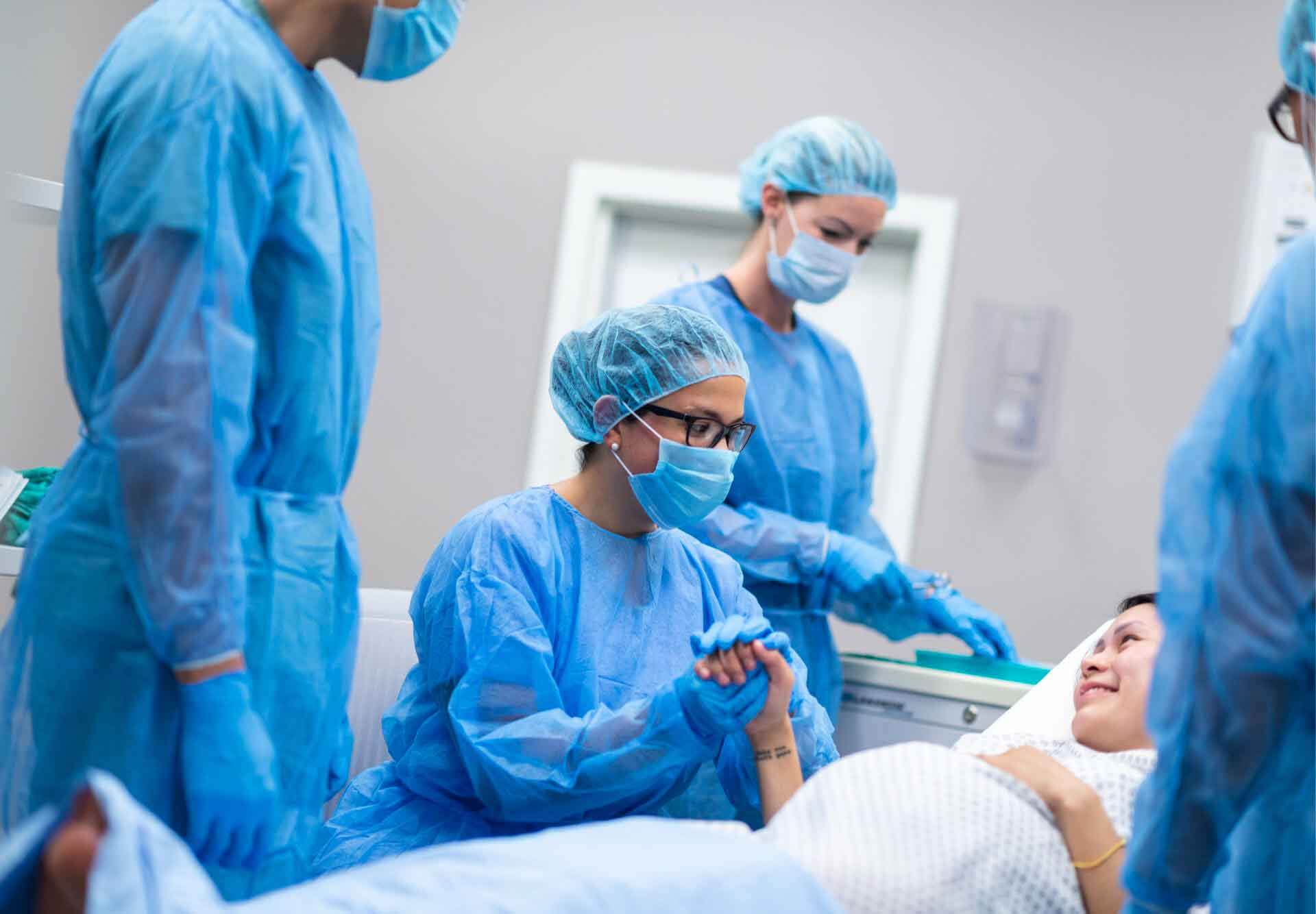Experiencing a Cesarean section and looking for a week-by-week timetable for C-section recovery? Our C-section recovery guide can help you prepare for potential side effects, scar care, and more during your healing journey.
Around one-third of all babies born in the United States today are delivered via cesarean section. Yet, a C-section delivery and the subsequent recuperation are rarely, if ever, described in detail in childbirth classes. Below is information regarding C-section healing week by week.
C-Section Day
Immediately following surgery, you will be transferred to a post-operative area (if your birthing place has one), where you will remain under observation while medical staff monitors your bleeding (from your vagina and incision), blood pressure, and temperature. While the effects of the anesthetic will not have gone off sufficiently for you to urinate on your own, an IV will provide fluids, and a catheter will assist in urination.
At this point, you will still lack sensation in your lower body because of the anesthesia, and if you had pain medication through your IV, you might feel unsteady and dizzy. The good news is that, barring problems, you will be able to hold and breastfeed your baby immediately.
When your anesthetic begins to wear off, your medical team will continue to watch you for several hours if there are no issues. You can begin eating, but you will be encouraged to transition cautiously from ice chips to liquids (such as broth and juice) before moving on to solids.
Following surgery, nurses will massage your uterus to stimulate contraction and natural size reduction. Unfortunately, this is not as spa-like as it sounds. Depending on the hospital, you may be encouraged to get out of bed on the same day if possible. Yeah, you have recently undergone major abdominal surgery, but the activity will aid in accelerating your C-section recovery.
One Day After C-Section
Typical C-section pain peaks 18 hours after birth. Dr. Sean Daneshmand, a perinatologist in San Diego, explains, “At that point, the pain medicine you were given with the spinal anesthesia wears off.” At that time, you will be given an oral narcotic, or you may receive “patient-controlled analgesia,” in which you administer your own Intravenous pain medication.
If your urinary catheter is still in place the day following your C-section, medical personnel will remove it. After this, you will be advised to get out of bed, since this will assist your bowels in moving more quickly and minimize gravity-related leg edema. You just had significant abdominal surgery, so don’t be shy about asking for assistance!
To prevent blood clots following surgery, you may be given a blood thinner (often a subcutaneous injection of Lovenox).
Two Days After C-Section
After the first day, we advocate starting the activity as quickly as possible; however, be aware that this may aggravate C-section pain. Increasing physical activity aids blood circulation, improves bowel function, and expedites recovery.
Moreover, you can take a shower within a day following surgery, which helps lower the chance of infection. Do not scrape your incision; allow soapy water to flow over it. (24-48 hours following surgery, your bandages will be removed and replaced with Steri-Strips, which can get wet.) Pat the area dry, or use a blow dryer with the cold setting.
Do you prefer a bath after a C-section? Unfortunately, it is not safe to submerge yourself in water until the incision has healed, which is typically seven to ten days after surgery.
At this point in your C-section recovery schedule, you will be wearing a pad for postpartum vaginal bleeding, which could linger for many weeks. (Yes, even following a Caesarean!) This completely normal discharge is known as lochia and consists of blood, mucus, and uterine tissue.
If not already, you are likely consuming solid meals at this point. It is quite typical to experience swelling following a C-section, and gas sensations can be painful. Once your bowels are moving normally again, they should pass within a week (Abdominal surgery temporarily “shuts down” the bowels, so pooping after a C-section may be difficult.).
In the meantime, using anti-gas medication, a stool softener, and walking around will assist. If you cannot walk long distances, ask your nurse if you can rock in the glider in your room; the rocking motion may also help release gas. Moreover, using an abdominal binder helps alleviate post-operative pain and improve mobility. Your doctor may advise you to take simethicone pills (such as Gas-X) to ease gas and bloating.
Four Days After C-Section
In contrast to parents who give birth vaginally, those who undergo a C-section may remain in the hospital for up to four days. Obviously, your hospital stay will be determined by your insurance coverage and the absence of issues. If you have staples, your doctor will remove them before you leave (sutures will dissolve on their own).
You will be instructed on how to care for your incision; the best course of action is to keep the wound clean and undisturbed. Rajiv B. Gala, M.D., the young physician-at-large for the American Academy of Obstetricians and Gynecologists, asserts, “There have been no good scientific studies indicating that any of the over-the-counter medications are superior to proper wound care.”
You will also be urged not to lift anything heavier than the baby and to avoid anything in the vagina, including penetrative intercourse (either alone or with a partner), menstruation products, and douche products (which should be avoided regardless) until after your six-week check-up.
To prevent infection, the American College of Obstetricians and Gynecologists (ACOG) suggests waiting several weeks before inserting anything into the vagina. In some instances, it is not advisable to drive or use the stairs immediately after a C-section, especially if you are experiencing pain. If you have a multi-story home, you might find a companion to relocate your basics downstairs, or at the very least, limit your travels so that you only climb the stairs when necessary.
Week 2 of Recovering from C-Section
At your postpartum visit, your doctor will evaluate your incision, which should not exhibit significant edema, redness, or symptoms of infection following a C-section. (Call your doctor if you experience these symptoms or a temperature greater than 100.4 degrees Fahrenheit.) Share your issues and request an update on the activity-related recommendations.
Even though it’s only been two weeks since your major abdominal surgery, you should feel significantly better at this point. But, you will experience C-section discomfort and cramps for several weeks. Dr. Daneshmand explains that it takes six weeks for the uterus to return to its usual size, regardless of the delivery method. In addition to a heating pad or hot water bottle, over-the-counter pain medications such as ibuprofen can provide relief.
Due to abdominal wall flexibility, you will continue to appear pregnant at this point (and, for many women, for much longer).
Week 4 of Recovering from C-Section
At this point in your C-section recovery, you will be able to move more swiftly and comfortably, take longer walks, and experience a decrease in bleeding. But keep your expectations realistic.
Our healing times are as unique as our DNA, so comparing yourself to others is pointless and will only discourage those who are taking a little longer to get better. If something hurts, slow down; if you’re exhausted, get as much rest as possible. And it is acceptable to use the pain drugs given by your doctor.
Week 6 of Recovering from C-Section
The initial phase of your primary healing is complete. Recovery following an uncomplicated cesarean section can take between four and six weeks. The healthier you are prior to surgery, the faster your recovery.
At this point, the majority of your sutures, if you had them, will have been around 50% absorbed, your uterus will have returned to its usual size, and you will be able to engage in intimate sexual activity. Some individuals may still have pain if they are bumped along the incision, but the wound is often completely healed at this time, and you can resume all normal activities.
Throughout the postpartum period, your body will continue to repair, so be sure to take it easy, relax frequently, and listen to your body as you adjust to your new life as a parent. And as a general rule, if you begin to feel worse rather than better during the postpartum period, you should contact your doctor. Never suffer in silence; aid is always just a phone call away.
Meaningful articles you might like: The Complete Guide To Lamaze Method, 10 Things You Probably You Didn’t Know About The Vagina, Is It Okay To Break Your Own Water?

